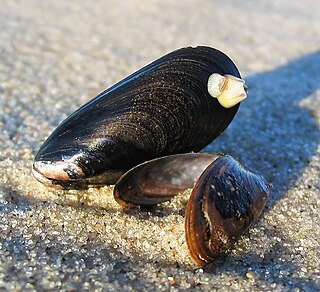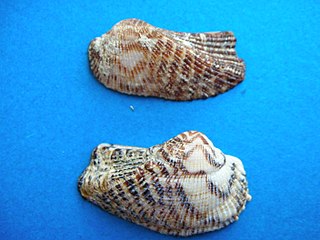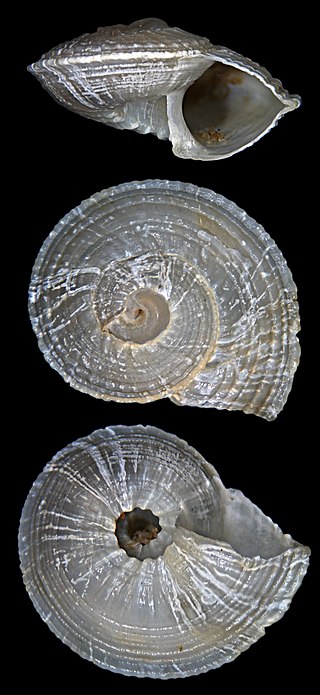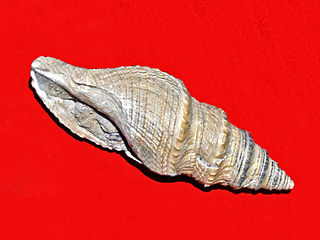
Scallop is a common name that encompasses various species of marine bivalve mollusks in the taxonomic family Pectinidae, the scallops. However, the common name "scallop" is also sometimes applied to species in other closely related families within the superfamily Pectinoidea, which also includes the thorny oysters.

A cockle is an edible marine bivalve mollusc. Although many small edible bivalves are loosely called cockles, true cockles are species in the family Cardiidae.

The Arcida is an extant order of bivalve molluscs. This order dates back to the lower Ordovician period. They are distinguished from related groups, such as the mussels, by having a straight hinge to the shells, and the adductor muscles being of equal size. The duplivincular ligament, taxodont dentition, and a shell microstructure consisting of the outer crossed lamellar and inner complex crossed lamellar layers are defining characters of this order.

Mytilidae are a family of small to large marine and brackish-water bivalve molluscs in the order Mytilida. One of the genera, Limnoperna, even inhabits freshwater environments. Mytilidae, which contains some 52 genera, is the only extant family within the order Mytilida.

Tridacna crocea, the boring clam, crocus clam, crocea clam or saffron-coloured clam, is a species of bivalve in the family Cardiidae. It is native to the Indo-Pacific region. It is occasionally found in the aquarium trade where it is often simply referred to as crocea.

Tornidae is a family of very small and minute sea snails with an operculum, marine gastropod mollusks in the clade Littorinimorpha. This family used to be known as the Vitrinellidae. Iredale has shown that the family Adeorbidae Monterosato, 1884 should be called Tornidae

Tectonatica is a genus of sea snails, marine gastropod molluscs in the subfamily Naticinae of the family Naticidae, the moon snails.

Monophorus is a genus of minute sea snails with left-handed shell-coiling, marine gastropod mollusks or micromollusks in the family Triphoridae.

Arca noae or the Noah's Ark shell is a species of bivalve mollusc in the family Arcidae. It is found in the Mediterranean Sea from low tide mark to a depth of 60 metres (200 ft).

Raphitomidae is a family of small to medium-sized sea snails, marine gastropod mollusks in the superfamily Conoidea.

Protobranchia is a subclass of bivalve molluscs. It contains the extant orders Nuculanida, Nuculida, and Solemyida.

Carlo Pollonera was an Italian painter, particularly of landscapes, and also an important malacologist.

Solatisonax is a genus of sea snails, marine gastropod mollusks in the family Architectonicidae, the staircase shells or sundials.
This bibliography lists publications authored by the Italian malacologist and painter Carlo Pollonera (1849-1923). The article endeavours to be comprehensive, and includes all works listed in previous bibliographies of Pollonera. Zoological Record and AnimalBase have also been utilised. Works listed without an internet link have generally not been examined directly. Dates given here follow those printed on the individual issue wrappers, which sometimes differ from those on the title page of the volume.

Pseudotoma is an extinct genus of predatory sea snails, marine gastropod mollusks belonging to the family Turridae.

Nucinellidae is a family of bivalves, in the order Solemyida. Its species are small and principally reside in deep-water environments. The species' average length is less than 5 millimetres (0.20 in), the largest species being Nucinella boucheti at a length of 25 millimetres (0.98 in). The family's characteristic features include large gills and reduced palps and their appendages; oval shells with few hinge teeth; they possess a single adductor muscle and one divided foot exhibiting papillae. The family contains two known genera: Huxleyia and Nucinella. Speaking of Nucinella, the genus' ligament system is of the simple arched type, lacking nymphae. Regarding the former, the system is "submerged" beneath its dorsal margin.
Ganula is a genus of gastropods belonging to the family Hygromiidae.

Sabatia is a genus of sea snails, marine gastropod molluscs in the family Scaphandridae, the canoe bubbles.

Saccella is a genus of bivalves belonging to the family Nuculanidae.
Alvania rotulata is an extinct species of minute sea snail, a marine gastropod mollusk or micromollusk in the family Rissoidae.

















